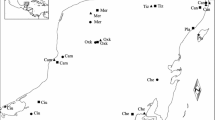Abstract
The polymorphism of 4 enzymatic systems of 21 Tetranychus urticae samples collected in southern France was analyzed in order to ascertain genetic differentiation within and between greenhouses. Genetic structure was investigated in relation to mite density, geographic distribution of greenhouses and the colonized host plant. We found that mite density and distribution of infested plants influence gene flow within greenhouses. Between greenhouses isolation by distance was significant. Differentiation did not appear to be associated with the colonized plant species.
Similar content being viewed by others
REFERENCES
Fisher, R.A. 1970. Statistical Methods for Research Workers, 14th edn. Oliver & Boyd, Edinburgh.
Garnier-Gere, P. and Dillmann, C. 1992. A computer program for testing pairwise linkage disequilibria in subdivided populations. J. Heredity 83: 239.
Gotoh, T., Bruin, J., Sabelis, M.W. and Menken, S.B.J. 1993. Host race formation in Tetranychus urticae: genetic differentiation, host plant preference, and mate choice in a tomato and a cucumber strain. Entomol. Exp. Appl. 68: 171–178.
Helle, W. and Pieterse, A.H. 1965. Genetic affinities between adjacent populations of spider mites (Tetranychus urticae Koch). Entomol. Exp. Appl. 8: 305–308.
Hinomoto, N. and Takafuji, A. 1994. Studies on the population structure of the two-spotted spider mite, Tetranychus urticae Koch, by allozyme variability analysis. Appl. Entomol. Zool. 29: 259–266.
Hinomoto, N. and Takafuji, A. 1995. Genetic changes in the population structure of the twospotted spider mite, Tetranychus urticae Koch (Acari: Tetranychidae), on vinyl-house strawberries. Appl. Entomol. Zool. 30: 521–528.
Holm, S. 1979. A simple sequentially rejective multiple test procedure. Scand. J. Stat. 6: 65–70.
Manly, B.F.J. 1985. The Statistics of Natural Selection on Animal Populations. Chapman & Hall, London.
Navajas, M. 1998. Host plant associations in the spider mite Tetranychus urticae (Acari: Tetranychidae): insights from molecular phylogeography. Exp. Appl. Acarol. 22: 201–214.
Nei, M. 1978. Estimation of average heterozygosity and genetic distance from a small number of individuals. Genetics 89: 583–590.
Ohta, T. 1982. Linkage disequilibrium due to random genetic drift in finite subdivided populations. Proc. Natl Acad. Sci. U.S.A. 79: 1940–1944.
Overmeer, W.P.J., Van Jon, A.Q. and Helle, W. 1975. The stability of acaricide resistance in spider mite (Tetranychus urticae) populations from rose houses. Entomol. Exp. Appl. 18: 68–74.
Raymond, M. and Rousset, F. 1995a. GENEPOP version 1.2: population genetics software for exact tests and ecumenicism. J. Heredity 86: 248–249.
Raymond, M. and Rousset, F. 1995b. An exact test for population differentiation. Evolution 49: 1280–1283.
Rousset, F. and Raymond, M. 1995. Testing heterozygote excess and deficiency. Genetics 140: 1413–1419.
Slatkin, M. 1993. Isolation by distance in equilibrium and non-equilibrium populations. Evolution 47: 264–279.
Sokal, R.R. and Rohlf, F.J. 1981. Biometry. W.H. Freeman and Co., New York.
Swofford, D.L. and Selander, R.B. 1981. BIOSYS-1: a FORTRAN program for the comprehensive analysis of electrophoretic data in population genetics and systematic. J. Heredity 72: 281–283.
Tsagkarakou, A. 1997. Structure génétique et mécanismes de la resistance aux insecticides organophosphorés chez Tetranychus urticae Koch (Acari: Tetranychidae). Thèse de l'Université Montpellier II, France.
Tsagkarakou, A., Navajas, M., Lagnel, J., Gutierrez, J. and Pasteur, N. 1996. Genetic variability in Tetranychus urticae from Greece (Acari: Tetranychidae): insecticide resistance and isoenzymes. J. Econ. Entomol. 89: 1354–1358.
Tsagkarakou, A., Navajas, M., Lagnel, J. and Pasteur, N. 1997. Population structure in the spider mite Tetranychus urticae (Acari: Tetranychidae) from Crete based on multiple allozymes. Heredity 78: 84–92.
Tsagkarakou, A., Navajas, M., Papaioannou-Souliotis, P. and Pasteur, N. (1998). Gene flow among Tetranychus urticae (Acari: Tetranychidae) populations in Greece. Mol. Ecol. 7: 71–79.
Weir, B.S. and Cockerham, C.C. 1984. Estimating F-statistics for the analysis of population structure. Evolution 38: 1358–1370.
Author information
Authors and Affiliations
Rights and permissions
About this article
Cite this article
Tsagkarakou, A., Navajas, M., Rousset, F. et al. Genetic Differentiation in Tetranychus Urticae (Acari: Tetranychidae) from greenhouses in France. Exp Appl Acarol 23, 365–378 (1999). https://doi.org/10.1023/A:1006293627880
Issue Date:
DOI: https://doi.org/10.1023/A:1006293627880




